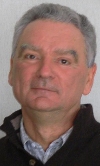Dissemination
- Workshops
- Past Workshops
- Schools and Seminars
- International Collaboration
- Publications
- Contributions to Standards
- Course Materials Available Online
Videos from the ARTIST Summer School in Europe 2009
Professor Nicolas Halbwachs
 Synchronous Programming, and its use for Modeling Non-synchronous Systems
Synchronous Programming, and its use for Modeling Non-synchronous SystemsProfessor Nicolas Halbwachs (VERIMAG Laboratory, France)
Synchronous languages are now widely used for programming safety critical embedded systems. Dedicated validation methods and tools have been developed for these formalisms. For instance, the Scade toolset, based on the synchronous data-flow language Lustre and developed by Esterel-Technologies, is used worldwide, in particular in avionics.
In this talk, we will first recall the principles of the synchronous paradigm. In a second part, we will show how synchronous formalisms can be used for modeling non synchronous systems, taking advantage of their associated tools for early simulation and validation of these systems. In the European integrated project ASSERT, we developed a translator from the architecture description language AADL to Lustre, allowing the joint modeling and simulation of software components (described with Scade or Lustre) and the implementation architecture on which these components are intended to run. As a case study, the methodology was applied to a very critical part of the control system of the "automatic transfer vehicule" (ATV), a spacecraft developed by Astrium.
printable slides
Click in the lower-right corner of the player to go to full screen.
(c) Artist Consortium, All Rights Reserved - 2006, 2007, 2008, 2009

